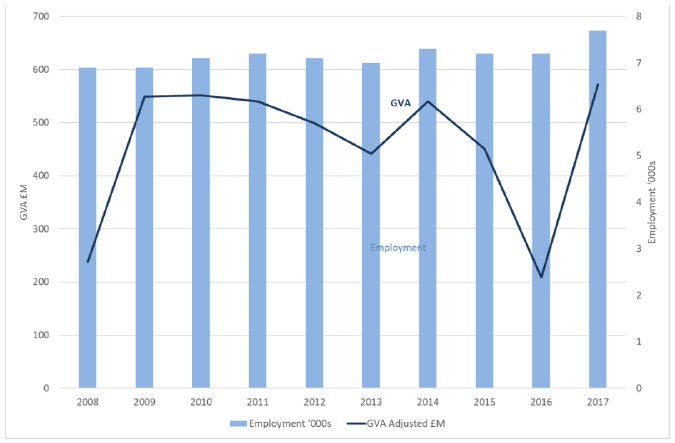Marine economic statistics 2017: corrected April 2020
Statistics on economic contributions of Scotland’s marine sectors present a time series of Gross Value Added (GVA), turnover and employment for industrial categories defined as part of the marine sector. This publication was originally published in October 2019 and was corrected in April 2020.
This document is part of a collection
7. Shipbuilding
7.1 Introduction
Shipbuilding is represented in this report by the SABS SIC codes 30.1: Building of ships and boats and 33.15: Repair and maintenance of ships and boats . As part of the SABS annual publications, Scottish Government publishes a Shipbuilding Profile where the Scottish shipbuilding sector is analysed in relation to UK economic sectors.
Shipbuilding data can fluctuate considerably due to the spasmodic nature of the industry's business. It can take a number of years to build and sell a ship, so purchase figures may be higher in some years and turnover higher in other years. Company re-structuring within the industry has also contributed to year-on-year fluctuations in statistics for the industry. The ONS estimation methodology produces regional estimates for both Scottish and non-Scottish business sites from single business returns which cover all UK activity. You can see the trends in a separate SABS Shipbuilding Profile. The SIC codes covered in the SABS shipbuilding profile provide a slightly narrower definition than the codes used for these marine economic statistics.
7.2 Key economic points
In 2017, Shipbuilding generated £572 million in GVA: accounting for 0.43% of the overall Scottish economy and 11% of the marine economy GVA. Shipbuilding provided employment for 7,700 people (headcount), contributing 0.3% of the total Scottish employment and 10% of the marine economy employment.
The SABS Shipbuilding Profile reports that Scottish shipbuilding accounted for around 29% of turnover and 24% of GVA of total UK output of the industry in 2017. This is a higher proportion than Scotland's contribution to the whole of manufacturing, where Scotland accounted for around 7% of turnover and 8% of GVA of total UK manufacturing in 2017.
7.3 Shipbuilding - trends
From 2016 to 2017 Shipbuilding GVA (adjusted to 2017 prices) increased by 174%, from a low value in 2016.
The SABS supporting notes on the Shipbuilding Profile indicate that changes in a small number of (large) companies can have a have a very marked effect on the statistics, particularly on sectoral and local authority figures, from one year to the next. They point out that at this level of analysis (4-digit SIC), particular caution should be exercised when looking at year-on-year changes for the sector. Instead, figures should be used to chart long-term trends.
| Year | GVA £M |
Turnover £M |
Employment Headcount 000's |
GVA Per Head £ |
|---|---|---|---|---|
| 2008 | 238 | 933 | 6.9 | 34,512 |
| 2009 | 549 | 1,478 | 6.9 | 79,568 |
| 2010 | 551 | 1,592 | 7.1 | 77,603 |
| 2011 | 540 | 1,564 | 7.2 | 75,016 |
| 2012 | 499 | 1,643 | 7.1 | 70,218 |
| 2013 | 442 | 1,302 | 7.0 | 63,083 |
| 2014 | 540 | 1,478 | 7.3 | 73,978 |
| 2015 | 451 | 1,702 | 7.2 | 62,579 |
| 2016 | 209 | 1,102 | 7.2 | 28,977 |
| 2017 | 572 | 1,561 | 7.7 | 74,221 |
Figure 11 shows the long term trend, demonstrating considerable fluctuation over the period 2008 to 2017. Over the same period, employment increased slightly to around 7,700 workers.

7.4 Shipbuilding - by geography
The SABS Shipbuilding profile reports that the top three local authority areas in the shipbuilding sector in 2017 were Glasgow City, Aberdeen City and Fife, which together accounted for 78% of employment, 86% of turnover and 78% of GVA in the sector. It is not possible to supply a full individual list of local authorities with shipbuilding activity without being disclosive.
Contact
Email: Venetia.Haynes@gov.scot
There is a problem
Thanks for your feedback